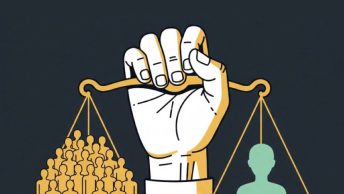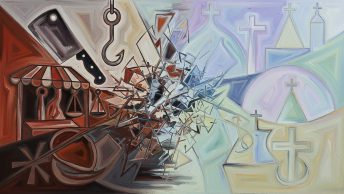The culture of impunity which thrives in the police force has manifested itself through custodial deaths, custodial torture and in many other ways. In the words of American scholar and activist Kate Millett, “There are no guarantees in captivity… Captivity is an entire state; entire helplessness before entire power”. In this piece, I shall focus on the humiliating tradition of the police forcing the accused to squat before the media and pose for photos, after the arrest.
Readers of newspapers and viewers of news channels are familiar with scenes of police personnel triumphantly posing with the accused kneeling/squatting in front of them. In the words of Justice Sonak, such scenes resemble erstwhile Maharajas and hunters posing with their trophies after a hunt. Neither the police nor the media seem to care about the legality of this practice and what it does to the accused. In 2012, the Supreme Court lambasted the Chhattisgarh Police for forcing a doctor accused of cheating to hold a placard and pose for a photograph, which was then published by the media. The placard disclosed his name and stated that he was a thief and a cheat. The Supreme Court directed that a compensation of Rs 5 Lakhs be paid to the doctor. It observed that, “There are some megalomaniac officers who conceive the perverse notion that they are the `Law’ ….. totally oblivious of the fact that living with dignity has been enshrined in our Constitutional philosophy and it has its ubiquitous presence, and the majesty and sacrosanctity dignity cannot be allowed to be crucified in the name of some kind of police action.”
In 2014, a three-judge bench of the Supreme Court objected to the practice of parading the accused before the media, observing that it was an ‘affront to the dignity of the accused’. The Andhra Pradesh High Court and the Bombay High Court too have adopted this view. However, there has been no end to this practice.
An Affront to Dignity and Privacy
The right to live with dignity has been recognized as a fundamental right by the Supreme Court, which interprets the right to life to mean a dignified life as opposed to mere animal existence. Dignity has also been declared as a constitutional value, which ensures the normative unity of human rights. The minimum content of dignity includes recognition of the intrinsic worth of every human being and the obligation of the State to respect this intrinsic worth. In order to protect this intrinsic worth, the Supreme Court has prohibited the State from treating suspects and undertrials in a manner, which defiles their personhood and humiliates them. For instance, the Supreme Court has prohibited the indiscriminate use of handcuffs and fetters while transporting arrestees and undertrials as it can cause humiliation and thereby violate dignity. Similarly, forcing the accused to squat and pose for a photo is a serious violation of dignity and privacy. It induces shame, creates stigma and can leave permanent scars on the psyche of the accused.
In the case of K.S Puttaswamy, the Supreme Court recognized the right to control one’s image as portrayed to the world as a facet of the right to privacy. The Court opined that privacy lets people protect themselves from troublesome judgements. Respecting the privacy of the accused is essential for protecting their dignity. While explaining the relationship between privacy and dignity in K.S Puttaswamy, the court stated that, “The right to privacy is an element of human dignity. The sanctity of privacy lies in its functional relationship with dignity. Privacy ensures that a human being can lead a life of dignity by securing the inner recesses of the human personality from unwanted intrusion.”
Furthermore, it is a grave violation of bodily privacy when a person is forced by the police to adopt a humiliating posture before the media. The publication of the photo affixes a badge of guilt and criminality. It causes irreparable harm to an accused’s reputation, as the humiliation suffered cannot be adequately remedied even if a court finds the accused not guilty later.
The Allahabad High Court, while directing the State of Uttar Pradesh to remove posters containing photos and names of those accused of damaging public property, observed that
“There are certain provisions empowering the investigating agencies or other executives to take picture of accused for the purpose of their identification and record but that too is not open for publication. The only time these photographs be published is to have assistance in the apprehension of a fugitive from justice.” The High Court declared that the publication of the accused’s photos was an unwarranted violation of privacy. It referred to the judgement of the Supreme Court in the case of Malak Singh, in which the Court held that photos of persons named in history sheets are to be stored confidentially and must not be displayed in the police station. Therefore, it is clear that the police are blatantly violating the law by forcing the accused to pose before the media.
The Adverse Effect on Due Process
By producing the accused before the media, the police actively facilitate a media trial and induce a perception of guilt in the minds of the public. This degrades the principle of an accused being innocent until proven guilty. Media trials can adversely affect due process as it can induce bias in the minds of judges and deny a fair trial to the accused. A press conference in which the police weave a strong narrative of the accused’s guilt and the image of the accused meekly squatting in front of the police can easily get entrenched in the minds of the public. Subsequently, even if a court declares the accused as not guilty, the public may still perceive the accused as guilty and not trust the judicial verdict. Allowing the media to publish photographs of the accused can also vitiate the sanctity of the Test Identification Parade as the identifier would have seen the faces of the accused before the parade is conducted and this can be prejudicial to the accused. Also, if the Test Identification Parade is compromised, the trial court may disregard its evidentiary value even if the victims or other witnesses have correctly identified the accused.
Why This Practice Thrives
The Law Commission of India briefly dealt with police-media relations and opined that the media often maligns the reputation of the police after a crime. In order to repair their reputation, the police disclose more than what is necessary, without respecting the rights of the accused. The Law Commission was critical of the media’s “temptation to sell stories” by violating the rights of the accused and the suspects. When the Bombay High Court asked the police to explain why an accused had been paraded before the media despite the practice being outlawed, the police replied that it had been done to ‘uplift the image of the police’ and pacify the media personnel at the police station who had demanded to photograph the accused. Forest officials and excise officials resort to this practice as well. It seems that the intention is to flaunt their success in solving a crime, shame the accused and publicly assert dominance over them. Therefore, there is no compelling state interest which can justify the violation of privacy and dignity through this practice and it is purely driven by personal and external preferences of the officers.
Conclusion
If the accused is at the mercy of the police who have scant regard for dignity and due process, it is a cruel joke on the Constitution. A tyrannical police force is a blot on the rule of law, and thus, there is an urgent need to reform and discipline the police force in India.








Your point of view caught my eye and was very interesting. Thanks. I have a question for you. https://accounts.binance.com/ro/register?ref=V3MG69RO
Thank you for your sharing. I am worried that I lack creative ideas. It is your article that makes me full of hope. Thank you. But, I have a question, can you help me?